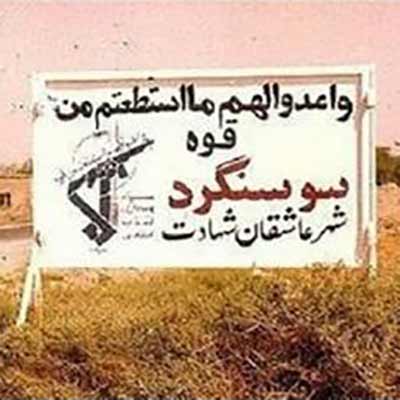Battles
Operation Ghayour Asli (Liberation of Susangerd)
Saeed Alameyan
241 Views
The operation to liberate Susangerd took place on November 17, 1980, with the participation of the Islamic Republic of Iran Army, the Islamic Revolutionary Guard Corps (IRGC), and the Mustafa Chamran Irregular Warfare Headquarters. As a result of this operation, the Iraqi Baathist army, after besieging the city’s defenders for three days and suffering heavy casualties, retreated, and Susangerd was liberated.
The Iraqi army first occupied Susangerd, located 60 kilometers northwest of Ahvaz, on September 29, 1980. However, two days later, with an ambush carried out by the IRGC forces in Ahvaz under the leadership of Ali Ghayour Asli, the city was liberated, and the Iraqi forces withdrew. Subsequently, during a 45-day gap between the first occupation and the second siege, the Iraqi army deployed two armored battalions, one mechanized infantry battalion, and one commando battalion to the border. On October 14, 1980, the Iraqis occupied Bostan, a town 25 kilometers west of Susangerd, which in turn was the next target for their military attack. However, given that the Iranians resisted, the enemy could only occupy 10 Kilometers from October 14 to November 12, 1980.
On November 14, 1980, the Iraqi armored force, which was as powerful as a brigade, blocked the Susangerd Road and advanced towards the Dehlaviyeh Road, effectively besieging Susangerd. That same day, there were intense clashes in Dehlaviyeh, leading to 30 Iranian fighters being martyred and 40 others wounded. Afterwards, the IRGC officials urgently informed Imam Khomeini’s representatives in various cities about the situation in Susangerd. By the morning of November 15, the Iraqi forces had reached a point just 1.5 kilometers from the city. Although 35 IRGC personnel resisted against the enemy with some mortar and RPG launchers, they were eventually surrounded. Out of this group, only 14 managed to escape, while the rest were martyred or captured. Between November 12th and 15th, three IRGC commanders—Morteza Yaghchian, Ali Tajallayei, and Sadeq Heydarkhani—were wounded in Susangerd. Despite being shot in the shoulder, Ali Tajallayei continued serving as the commander.[1]
Meanwhile, Ayatollah Seyyed Ali Khamenei, Imam Khomeini’s representative in the Supreme Defense Council at the time, was deeply concerned about the situation in Susangerd. During a council meeting in Tehran, he warned that if the city fell, its defenders would be martyred, saying:
“I said losing our brothers in the battlefield would cause greater damage than losing the city because we can retake the city, but we cannot bring back the fighters. Abulhassan Bani-Sadr, the then-President and Commander-in-Chief, said: ‘I am handling this matter. ’ The meeting ended quickly so Bani-Sadr could take the necessary actions”. However, after following up with military and IRGC officials, he realized that no action had been taken. As a result, on November 16th, he traveled to Ahvaz and, in a phone call, expressed his concerns, urging Bani-Sadr to issue orders in this regard. Bani-Sadr replied:
“It would be good if you visited the Army Headquarters and encouraged the officers. I will also issue the necessary orders”.[2]
On the afternoon of November 16, 1980, a meeting was held in the 92nd Armored Division’s War Room attended by Ayatollah Khamenei, Mustafa Chamran (Commander of the Irregular Warfare Headquarters), Brigadier General Valiollah Fallahi (Chief of Staff of the Army), Brigadier General Qasemali Zahirnejad (Commander of the Gendarmerie and the Army Ground Forces), Colonel Gholamreza Qasemi (Commander of the 92nd Armored Division), Davoud Karimi (IRGC Operations Commander), Hassan Baqeri (Head of Intelligence at the IRGC Operations Headquarters), and Seyyed Muhammad Gharazi (Governor of Khuzestan). In this meeting, they devised a plan for the liberation of Susangerd based on the information provided by Hassan Baqeri. Accordingly, the 2nd Brigade of the 92nd Armored Division, along with 120 IRGC forces equipped with anti-tank weapons, would break the siege of Susangerd. The forces under the command of the Chamran Irregular Warfare and the Basij would secure the supply route and protect the rear and flanks of the battlefield. The operation was scheduled for 5 AM on November 17, 1980. Following the meeting, Brigadier General Zahirnejad traveled to Dezful to inform Bani-Sadr about the plan.[3]
At midnight, Governor Gharazi informed Davoud Karimi that Bani-Sadr had ordered the 2nd Brigade to withdraw from the operation. Karimi immediately relayed this information to Ayatollah Khamenei over the phone. In response, he wrote a letter:
Monday, November 17, 1980 – 1:10 AM
To: Colonel Qasemi, Commander of the 92nd Armored Division, Ahvaz
Dear Colonel Qasemi,
I have heard that General Zahirnejad has called you, saying that the 2nd Brigade should not engage in the tomorrow operation unless explicitly ordered. He meant that the order must come from the President. I find this reversal of the decision unreasonable because it means driving the operation towards failure. The enemy is so powerful and will not be defeated with only two infantry companies. Therefore, if the brigade does not engage, the assault will not effectively take place.
If we wait until morning for General Zahirnejad’s arrival to make the final decision, we will run out of time. Our brothers in Susangerd will resist only until morning, and if we do not relieve some of the enemy’s pressure early, they will all be killed, and the city will completely fall.
In short, based on our assessment and judgment, the plan must proceed as discussed, and the brigade should be ready to engage in the morning. Otherwise, the responsibility for the fall of Susangerd lies with whoever reversed this decision.
Seyyed Ali Khamenei[4]
That same night, Shahab al-Din Eshraqi, (Imam Khomeini’s son-in-law) had called Ayatollah Khamenei to talk about the situation in Susangerd:
“Earlier in the evening, the late Eshraghi, (Imam Khomeini’s son-in-law), called me from Tehran asking for an update on the situation in Susangerd. I told him that the operation would be carried out as planned. However, I also expressed doubts saying I am concerned that the operation might not take place unless Imam Khomeini (ra) issues an order. He then talked to Imam Khomeini (ra) and later conveyed his message: He had ordered that Susangerd must be liberated by tomorrow and that General Fallahi should personally oversee the operation. I handed the letter to one of the brothers and told him: ‘Take this letter to Colonel Qasemi and even if he was asleep, wake him up and make sure he receives it’”.[5]
The tone and firmness of the letter had an immediate impact. Shortly thereafter, General Zahirnejad called Colonel Qasemi and informed him that he had spoken with the President, who had stated that, if necessary, the 2nd Brigade would be deployed.
On November 17, 1980, the operation began, though with some delay, according to the planned strategy. By 1:30 PM, the volunteer infantry forces, the IRGC, and the forces of the Irregular Warfare Headquarters, supported by the 2nd Brigade, managed to liberate Susangerd.[6]
By bombing enemy equipment and providing air cover, the pilots from Dezful, Tabriz, Hamedan, Isfahan, and Shiraz airbases played a significant role in this operation, contributing greatly to its success. On this day, an Iraqi Air Force MiG-23 was shot down by the Islamic Republic of Iran Air Defense Force.[7]
In addition, the Army Aviation (Havanirouz) pilots destroyed 22 Iraqi tanks, 20 troop transport trucks, 12 Jeeps, several fuel tankers, ammunition trucks, and communication equipment in the Susangerd, Hamidiyeh, and Bostan.[8]
The logistical damages inflicted on Iraq during this operation included the destruction of 174 tanks, 8 armored personnel carriers, 5 trucks, 49 artillery pieces, 23 ammunition transport vehicles, 7 ammunition tents, 3 missile transport vehicles, 2 bulldozers, 4 BM-21 Grads, 2 heavy machine guns, 1 anti-aircraft gun, 1 mortar launcher and 29 military vehicles. Furthermore, 750 Iraqi soldiers were killed or wounded, and 18 were captured.[9]
[1] Saeed Alameian, Hassan Baqeri, Vol. 1: Revayat-e Zendegi (A Life Narrative), Tehran: Markaz-e Nashr-e Asar-e Shahid Hassan Baqeri, 2011, Pp. 395–399.
[2] Saf (Monthly Magazine of the Islamic Republic of Iran Army), No. 392, November 2013, p. 10.
[3] Hassan Baqeri, Vol. 1, p. 400.
[4] Ibid., Pp. 387–388.
[5] Saf (Monthly Magazine of the Islamic Republic of Iran Army), Ibid., p. 12.
[6] Saeed Alameian, Molaqat dar Fakeh: Zendeginame-ye Shahid Hassan Baqeri (Gholamhussain Afshordi) (Meeting in Fakeh: The Biography of Martyr Hassan Baqeri), Tehran: Soore Mehr, 2017, p. 121.
[7] Saf (Monthly Magazine of the Islamic Republic of Iran Army), Ibid., p. 91.
[8] Ibid., p. 95.
[9] Ibid., p. 52.





